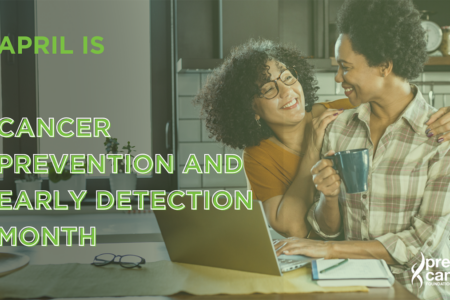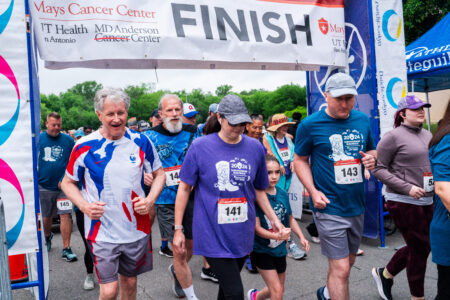
Share On Social!
This is part of the “Advancing the Science of Cancer in Latinos: 2022 Conference Proceedings,” which summarizes findings and discussions of the 2022 Advancing the Science of Cancer in Latinos Conference on Feb. 23-25, 2022, in San Antonio, Texas.
Using Science to Address Latino Health Inconsistencies in Research
Eliseo J. Pérez-Stable, M.D., is Director of the NIMHD at the National Institutes of Health (NIH).
Health Differences and Non-Medical Drivers of Health
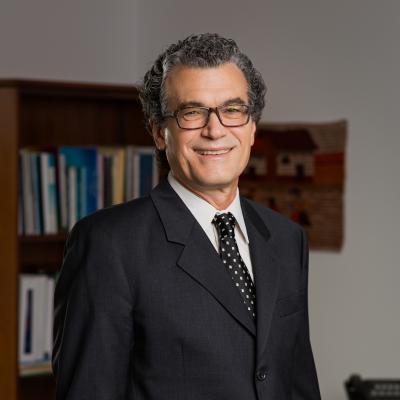
Dr. Pérez-Stable began his presentation by discussing the ways in which science can reduce differences in healthcare. First, standardized surveys, tools, and measurements are needed so that data can be combined, facilitating discovery through large data sets. Science should also be an engine for promoting variety in the scientific and clinical workforce, cultivating community engagement, and building trust for sustainable relationships. Community engagement should be considered an essential platform for doing research especially in reducing health differences. Finally, there is a large body of evidence on efficacy of interventions and yet our systems often fail in implementing these interventions in the most overlooked communities.
NIMHD defines populations with health differences as one of the following populations that are impacted by factors related to the non-medical drivers of health. All these populations have a handicap when it comes to health care. NIMHD defines a health difference as having a worse health outcome compared to the reference population. In response to these health differences, and in an attempt to standardize data, NIMHD started the Non-Medical Drivers of Health common data elements as part of the PhenX Toolkit. Non-medical drivers of health are contributing factors to inequity such as background identity, spirituality, language proficiency, literacy, housing, broadband, transportation, schools, and more.
One of the more important non-medical drivers of health shows a startling association with mortality. US residents in a household of four with an income less than $25,000 show a mortality ratio of 3:1 when compared to those with a household income of greater than $115,000. Education level of the head of household is another striking non-medical drivers of health, with male Latino children showing a 24.4% prevalence of obesity if their head of household achieved less than a high school education, compared with a 12.9% prevalence of obesity if their head of household has a college degree.
NIMHD Initiatives
NIMHD’s purpose is to counter these differences is through multiple initiatives. NIMHD funding has steadily increased over the past decade, with larger funding expected in fiscal year 2022 to address the differences made evident by the pandemic and the awakening to the issues surrounding them. Although the success rate of R01 grant applications in 2021 was 12.9%, that number is expected to improve with more funding. Also, Career Development (K) awards have been expanded and are generally funded based on score and available budget. Many NIMHD funding opportunities were recently announced, including health of immigrant populations, patient-clinician communication, social epigenomics, sleep disparities, liver cancer, lung cancer etiology, and more.
One of NIMHD’s initiatives is the Health [Differences] Research Institute, a week-long intensive training experience launched in 2016 targeted to early-stage investigators and postdoctoral fellows. The training includes lectures by selected leading scientists, a mock grant review session using real applications, a writing course sponsored by the American Association of Medical Colleges (AAMC), meetings with NIH scientific program staff, and consultations on the development of research interests into a K or R01 application. Of the 332 participants in the past six years, about 60% came from underrepresented race/ethnic groups and 20% were physicians.
COVID and CEAL
In 2020, there were 477,000 excess deaths in the US, 74% of which were from COVID-19. Case rates and hospitalizations due to COVID-19 were two to three times higher in Latino, African American, and American Indian/Alaskan Native populations compared to White populations. To counteract these differences, the NIH established the Community Engagement Alliance (CEAL) Against COVID-19 [Differences]. CEAL’s overarching goals include understanding factors that contribute to the unfair burden of COVID-19 in some of these communities; supporting effective community-engaged strategies to address incorrect information and mistrust; and promoting education, awareness, trust, access, and inclusion in COVID-19 research, prevention, and treatment. CEAL’s mantra is “move at the speed of trust,” an ideal pursued by supporting initiatives such as telehealth hotlines in Texas; supporting agricultural workers in California’s Central Valley; fighting misinformation with fotonovelas; collaborating with the White House to speak on Spanish-language media; working with stakeholders to produce educational Spanish-language conversations; the Salud America! Podcast; and other online resources.
Dr. Pérez-Stable closed by the root cause of these differences and the importance of patient-clinician communication for improved patient satisfaction and health outcomes. Part of this strategy involves training more African American and Latino clinicians since these physicians care for more than 50% of minorities and more than 70% of those with limited English proficiency. Expanding access to health insurance, coordinating care, emphasizing patient-centered care, and community-engaged research should also be utilized to counter health differences. By implementing these strategies and continuing to hold the health care system accountable, change can become reality.
Update from the National Cancer Institute
Dr. Katrina Goddard is Director of the Division of Cancer Control and Population Sciences (DCCPS) at the National Cancer Institute (NCI).
Challenges Facing the Latino Community
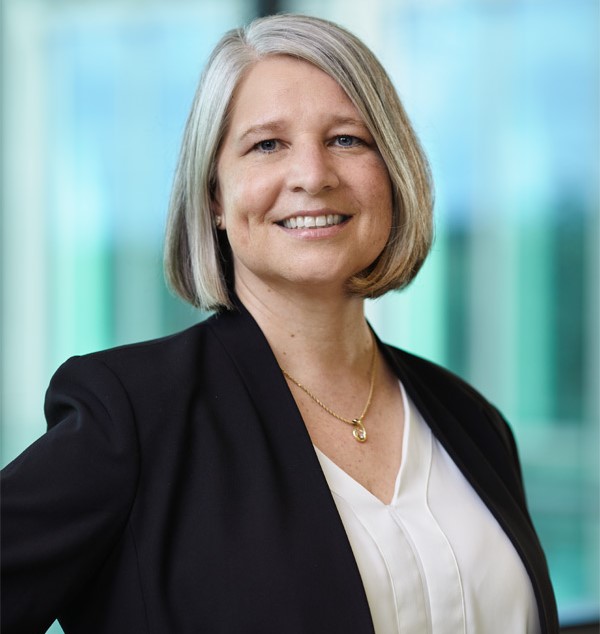
Dr. Goddard began by reflecting on the 2020 presentation of her predecessor as Director of the DCCPS, Dr. Bob Croyle. In that presentation, Dr. Croyle outlined challenges facing the Latino community, including the rapid population growth among the US Hispanic population; aggregated data masking important differences within the heterogeneous Hispanic population; higher rates of infection-related cancers among Latino patients; cancer incidence varying substantially by nativity; misclassification of background in medical records; the frequency of incomplete information on place of birth; and multiple risk factors compared to the White population, such as lower educational attainment, increased poverty, language challenges, increased obesity, and high uninsured rates. Incorrect information is another challenge affecting the Latino community, with social media incorrect information even more prevalent in Spanish posts than in English.
The SEER Program
In order to address these challenges, NCI has focused on creating change in four areas, the first being improved data collection and analysis to support subgroup-specific cancer rates and trends. To this end, the Survey, Epidemiology, and End Results (SEER) program has been expanded to now cover about 50% of cancer cases in the US. Since the changes in 2021, 69.2% of cancer cases among Hispanic patients are now included in the SEER registry, compared to less than 45% from 2015 to 2020. However, because the registry does not collect information directly from patients, but extracts information from existing medical records and through linkages with other data sources, incomplete or inaccurate information continues to be a problem.
In order to fill these data gaps, DCCPS has turned to geographic data sources, incorporating these into the SEER program. State Cancer Profiles and census tract information can be used to assess areas of high cancer incidence, and pair that data with overall demographic information for that area. For example, in an assessment of liver and bile duct cancer in Texas, Hispanic patients were found to have higher incidence of these cancers across five different socioeconomic categories, with very little difference between rural and urban areas. White patients, however, showed much lower rates in rural areas compared with urban areas.
Background Appropriate Interventions and Clinical Trial Participation
NCI’s second area of focus has been supporting the development and adaptation of background appropriate interventions for increasing the uptake of preventive services and adoption of healthy lifestyles. To this end, NCI has funded many clinical trials focusing on Hispanic populations across the cancer care continuum, and the DCCPS has funded many research grants. Although NCI’s funding opportunities are too numerous to list, Dr. Goddard highlighted the opportunities focused on workforce diversity, training to promote diversity, and international collaboration.
The third area of focus by NCI is increasing Hispanic/Latino enrollment in clinical trials and cohort studies with high-quality, annotated biospecimens. To further this work, the DCCPS created the Cancer Epidemiology Descriptive Cohort Database (CEDCD), a searchable database containing descriptive information about cohort studies that follow groups of people over time for cancer incidence, mortality, and other health outcomes. The goal of the database is to facilitate collaboration and highlight the opportunities for research within existing cohort studies. Two recent studies included in the database are the Leading Pathways study by Drs. Frank Penedo and Amelie Ramirez, and the Survivorship and Access to care for Latinos to Understand and address [Differences] (SALUD) study by Dr. Michael Scheurer.
DCCPS-Supported Research Infrastructure
The final focus of the NCI is leveraging all DCCPS-supported research infrastructure. There has recently been tremendous growth in health differences work at DCCPS, with 76% of grantees now focusing on either understudied populations, health differences, or both. The Cancer Epidemiology in Hispanic Populations Virtual Workshop is another part of this infrastructure, identifying scientific gaps and opportunities for cancer research in Hispanic populations. Another resource is the “Did You Know?” YouTube video series, educating patients on common questions regarding various cancers. Finally, DCCPS has developed the Health [Differences] Calculator (HD*Calc), a tool that allows scientists to apply statistical analyses to the SEER database.
The Future of DCCPS
Rural cancer control is a key future DCCPS initiative, with the department recently funding nine R1 applications. Another focus is the relationship between persistent poverty and cancer, with persistent poverty being defined as more than 20% of people living in a census tract having been beneath the federal poverty level since at least 1980. The Continuing Umbrella of Research Experiences (CURE), another area of future focus, offers unique training and career development opportunities to enhance and increase diversity in the cancer and cancer health differences research workforce. Finally, the Cancer Moonshot has been reignited by President Biden. This initiative seeks to accelerate scientific discovery in cancer, foster greater collaboration, and improve the sharing of data, with the goal of cutting today’s age-adjusted death rate from cancer by at least 50 percent over the next 25 years. With the help of these ambitious and collaborative initiatives, the DCCPS and NCI seek to drastically improve cancer outcomes, especially in communities experiencing health differences.
Cancer Epidemiology in Hispanic Populations: Overview, Future Directions, and Resources
Dr. Tram Kim Lam is a Program Director in the Environmental Epidemiology Branch of the Epidemiology and Genomics Research Program (EGRP) in the National Cancer Institute’s (NCI) Division of Cancer Control and Population Sciences (DCCPS).
The Cancer Epidemiology in Hispanic Populations Virtual Workshop

Dr. Tram Kim Lam began by providing a summary of the Cancer Epidemiology in Hispanic Populations Virtual Workshop, a three-day workshop held in September of 2021. The workshop sought to identify scientific gaps and opportunities for cancer epidemiology research in Hispanic populations, to encourage the use of existing resources and identify gaps in resources to enable cancer epidemiological research in Hispanic populations, and to facilitate and coordinate cross-discipline collaboration to inform research in Hispanic populations.
Funded Cancer Epidemiology Research in Hispanic/Latino Populations
Dr. Lam also highlighted cancer epidemiology research studies from 2016 to 2021 that focused on Hispanic/Latino populations. The Leading Pathways study by Drs. Frank Penedo and Amelie Ramirez was an important Hispanic/Latino cancer survivorship cohort study. The Survivorship and Access to care for Latinos to Understand and address [Differences] (SALUD) study by Dr. Michael Scheurer assessed pediatric cancer survivors. The Discovering cancer Risks from Environmental contaminants And Maternal/child health (DREAM) study by Drs. Tracey Woodruff and Peggy Reynolds focused on the environmental exposure of Hispanic and Asian women. Finally, the Southern Liver Health Cohort represents the first large-scale effort to longitudinally determine the link between environmental contaminants, liver disease, and cancer in a residentially and having a population that looks like the US. With these research initiatives and others funded by the NCI, our knowledge of the field of cancer epidemiology in Hispanic populations is broadening and information gaps are being filled.
Optimizing Patient-Clinician Communication for Hispanic/Latino Persons with Cancer through Open Notes and the 21st Century Cures Act
Dr. Carli Zegers is Assistant Professor in the School of Nursing at the University of Kansas, and an Emergency Department Nurse Practitioner at University Health Truman Medical Center.
The 21st Century Cures Act
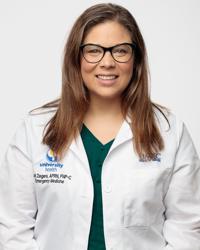
Dr. Zegers began by giving background on the 21st Century Cures Act. Part of this act, the Interoperability and Information Blocking Rule, was passed on April 5, 2021, and requires clinicians to provide patients with on-demand access to clinical notes using a tool such as OpenNotes. Since patient-clinician communication in the cancer setting is complex, with added non-medical drivers of health affecting Hispanic/Latino patients and their families, this act provides a tool to combat health differences. Access to cancer care and specialists, communication about insurance and cost burden, health literacy, and linguistic and cultural discordance can all be improved through access to clinical notes. This is especially important since it is known that insufficient communication in the Hispanic/Latino community results in unmet needs in the areas of support, satisfaction, increased symptom burden, decreased patient activation, and knowledge deficits.
An OpenNotes Study
Dr. Zegers is conducting a convergent, parallel, mixed-methods study using interviews and surveys to conduct a cross-analysis of Hispanic/Latino and non-Hispanic/Latino patients. Interviews focused on understanding how patients are or are not using information that their health care team shared in the MyChart section of OpenNotes and assessing the impact of shared clinical notes and test results on their cancer care experience. Additionally, a clinical note was read with the interviewer, and the interviewee made suggestions for improvement. Surveys included demographic information; a questionnaire to gain a general sense of patients’ knowledge, confidence, comfort, and concerns with OpenNotes; and the Functional, Communicative, and Critical Health Literacy Tool. Recruitment was performed using a University of Kansas Cancer Center program called Curated Cancer Clinical Outcomes Database (C3OD). This database contains 116,524 active cancer patients, 3389 of which are Hispanic/Latino.
Themes of the Study
General themes that have emerged from the study include a feeling of data ownership. Patients often made comments such as ”It’s my data,” “I don’t have to wait,” and “I can share with others.” Another theme was control of care. Patients felt a sense of control, saying “I feel more in control,” “I have something to refer back to to help me recall,” and “I feel more comfortable/knowledgeable/in control of my cancer care.” Some negative impacts of increased access also emerged, however. Patients expressed concerns that “messages from the care team can appear non-compassionate,” that the lag time between receiving results and being able to talk about them with a physician causes anxiety, and that the instant access to results increases anxiety and worry.
Some positive themes emerged that were specific to Hispanic/Latino patients. In the area of role management, for example, patients made comments such as “I use the notes to advocate, not take ‘no’ for an answer,” and “I can manage my care and my dad’s care.” Improved communication was also important, with patients noting, “[MyChart] lets me immediately communicate with [the oncologist] and message back and forth.” One survey question asked “What would make you comfortable?” Responses included a template for medical abbreviations or terms, explanations during office visits, and the ability to opt out of receiving information. Patients’ highest medical concerns involved medical terms, privacy, bad news, and understanding.
Benefits of Improved Communication
Conclusions of the study were many. First, whether the patient was at the beginning of their patient journey or farther along made a difference on the impact of OpenNotes. Furthermore, Hispanic/Latino participants had unique uses for OpenNotes, especially as caregivers. Although OpenNotes was generally supported and viewed as beneficial, privacy was a concern. It is important to note that providers must be considerate of anxiety and have options to prevent harm. For example, releasing a radiology report on a Friday evening, with no option for the patient to consult with anyone until the following Monday, can cause extreme anxiety. Overall, the study found that partnerships between providers and patients are important and are supported by this resource, and OpenNotes allows individuals to speak up better, be prepared, ask questions, and locate valuable resources.
Dr. Zegers concluded by noting areas where further research is needed. For example, more information on the impact of OpenNotes on the Hispanic/Latino community is needed, as early data suggests unique patterns of use in this community. More research on dissemination and implementation strategies is also vital, specifically to engage individuals in the Hispanic/Latino community. Despite this need for more study, however, initial results on the 21st Century Cures Act prove promising in addressing communication gaps between providers and patients.
Explore More:
CancerBy The Numbers
142
Percent
Expected rise in Latino cancer cases in coming years

